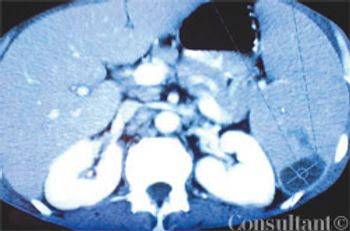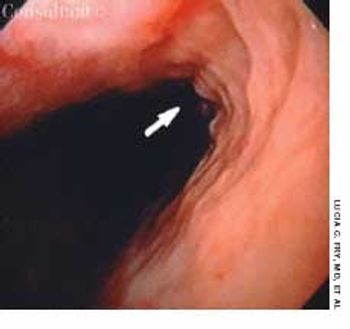
Although widely regarded as a raredisorder, hereditary hemochromatosisis the most common genetic disease inCaucasians. In certain populations ofnorthern European descent, 1 of every200 persons is homozygous for thecausative mutation.1

Although widely regarded as a raredisorder, hereditary hemochromatosisis the most common genetic disease inCaucasians. In certain populations ofnorthern European descent, 1 of every200 persons is homozygous for thecausative mutation.1

Abstract: In the assessment of community-acquired pneumonia, an effort should be made to identify the causal pathogen, since this may permit more focused treatment. However, diagnostic testing should not delay appropriate empiric therapy. The selection of empiric therapy can be guided by a patient stratification system that is based on the severity of illness and underlying risk factors for specific pathogens. For example, outpatients who do not have underlying cardiopulmonary disease or other risk factors can be given azithromycin, clarithromycin, or doxycycline. Higher-risk outpatients should be given a ß-lactam antibiotic plus azithromycin, clarithromycin, or doxycycline, or monotherapy with a fluoroquinolone. If the patient fails to respond to therapy, it may be necessary to do bronchoscopy; CT of the chest; or serologic testing for Legionella species, Mycoplasma pneumoniae, viruses, or other pathogens. (J Respir Dis. 2006;27(2):54-67)

My patient has been hospitalized for pneumonia several times by different physicians. He has never received the pneumococcal vaccine. Can this vaccine begiven during the patient’s hospital stay?

There's a curse frequently attributed to the Chinese, "May you live in interesting times." It seems that we find ourselves living in interesting times right now. The Department of Homeland Security recently heightened our threat levelfrom code yellow to code orange. Duct tape, plastic wrap, and flashlights are in short supply at local hardware stores. There’s been more talk about smallpox and the smallpox vaccine, and parents and colleagues are eager for more information.

Most pain in or around the oral cavity is attributable to tooth or mucosal pathology. However, tooth or mucosal pain may also be caused by a variety of other conditions, including brain pathology; vascular inflammatory and cardiac disease; jaw infection or neoplasm; neuropathic abnormality not associated with central pathology; pathology in the neck and thoracic region; myofascial and temporomandibular joint pathology; and disease of the ear, eye, or nose, or of the paranasal sinuses, lymph nodes, and salivary glands. Accurate diagnosis is facilitated when the features of pain presentation in this region are understood.

Abstract: Shortness of breath is a common complaint associated with a number of conditions. Although the results of the history and physical examination, chest radiography, and spirometry frequently identify the diagnosis, dyspnea that remains unexplained after the initial evaluation can be problematic. A stepwise approach that focuses further testing on the most likely diagnoses is most effective in younger patients. Early bronchoprovocation challenge testing is warranted in younger patients because of the high prevalence of asthma in this population. Older patients require more complete evaluation because of their increased risk of multiple cardiopulmonary abnormalities. For patients who have multiple contributing factors or no clear diagnosis, cardiopulmonary exercise testing can help prioritize treatment and focus further evaluation. (J Respir Dis. 2006;27(1):10-24)

ABSTRACT: A scheme-based approach, supported by a simple mnemonic, can narrow the broad differential diagnosis of thrombocytopenia. This approach uses findings from the complete blood cell count and the peripheral smear to organize the possible causes of thrombocytopenia into those that affect only platelet count, those that produce both a low platelet count and hemolytic anemia, and those that produce disturbances in all 3 blood cell lines. Causes of isolated thrombocytopenia include viral infections, immune-mediated platelet destruction, congenital diseases, gestational thrombocytopenia, conditions in which splenomegaly is a prominent feature, antiphospholipid antibody syndrome, infectious diseases of bacterial origin, and drugs. Causes of thrombocytopenia in conjunction with hemolytic anemia include hemolytic uremic syndrome, thrombotic thrombocytopenia purpura, and disseminated intravascular coagulation. Disorders that produce disturbances in all 3 blood cell lines include aplastic anemia, myeloproliferative syndromes, myelodysplasia (both primary and secondary), myelofibrosis, myelophthisis, and several other diseases in which splenomegaly is prominent.

ABSTRACT: A number of nondental conditions may cause significant oral pain. Pain associated with temporal arteritis is localized to the maxillary posterior teeth, the maxilla, or the frontal-temple region. This pain is often associated with exquisite tenderness of the scalp and face. The pain of trigeminal neuralgia is typically felt in the anterior maxillary or mandibular anterior teeth; it radiates along the mandible toward or into the ear on the ipsilateral side of the trigger. Pain may remit for months or years but is often severe when it recurs. Burning mouth syndrome preferentially affects postmenopausal women older than 50 years; one half to two thirds of patients experience spontaneous remission within 6 to 7 years, with or without treatment. The pain of postherpetic neuralgia is unilateral and restricted to the affected dermatome; it may be aggravated by mechanical contact or chewing.

56-year-old man with a history of diabetes mellitus and hypertension presents with chest pain, emesis, pallor, and diaphoresis.

A 56-year-old woman presents for a routine examination. She has been healthy, and results of previous examinations have been normal.

A 57-year-old woman complains of burning and dryness in her left eye and altered sensation in her mouth when eating; these symptoms began the day before. A coworker who had noticed facial asymmetry recommended that she seek medical attention.

A 51-year-old man with a history of AIDS (CD4 count of 59 cells/µL), anemia, neutropenia, and AIDS-related dementia presented with persistent fever, abdominal pain, and diarrhea of 2 months' duration. He did not adhere to his regimen of HAART and prophylactic therapy with atovaquone and azithromycin.

A 36-year-old homosexual man presented with a 2-week history of odynophagia to liquids and solids; he had no dysphagia or heartburn. The patient, who had been seropositive for HIV for 3 years, had refused all antiretroviral drugs and prophylactic agents against opportunistic infections.

Telltale skin lesions of syphilis, gonorrhea, human papillomavirus infection, and Haemophilus ducreyi infection.

Telltale skin lesions of syphilis, gonorrhea, human papillomavirus infection, and Haemophilus ducreyi infection.

The authors describe the development of pneumonitis in a patient who had initially presented with edema of the lower extremities. Biopsy results supported the conclusion that the pneumonitis was caused by silicone injections the patient had received 5 years earlier.

The initial evaluation of a patient with community-acquired pneumonia (CAP) should include a careful search for comorbidities, according to a study by Falguera and associates.

Abstract: In addition to causing pulmonary disease, infection with Mycobacterium tuberculosis can result in a wide range of extrapulmonary manifestations, including abdominal involvement. Patients with acute tuberculous peritonitis typically present with fever, weight loss, night sweats, and abdominal pain and swelling. Intestinal tuberculosis is characterized by weight loss, anorexia, and abdominal pain (usually in the right lower quadrant). A palpable abdominal mass may be present. Patients with primary hepatic tuberculosis may have a hard, nodular liver or recurrent jaundice. The workup may involve tuberculin skin testing, imaging studies, fine-needle aspiration, colonoscopy, and peritoneal biopsy. Percutaneous liver biopsy and laparoscopy are the main methods of diagnosing primary hepatic tuberculosis. Treatment includes antituberculosis drug therapy and, in some cases, surgery. (J Respir Dis. 2005;26(11):485-488)

An HIV-positive 38-year-old man with a history of injection drug use presented to the emergency department with abdominal and back pain that worsened with motion. He denied fever and vomiting. During the past 2 months, the patient had been treated for a urinary tract infection (UTI) 4 times and evaluated for a renal calculus, which had been ruled out. He was currently receiving ciprofloxacin, ibuprofen, and HAART.

Telltale skin lesions of syphilis, gonorrhea, human papillomavirus infection, and Haemophilus ducreyi infection.

A 35-year-old man with type 1 diabetes has had an asymptomatic rash on the lower extremities for the past several months. He denies trauma and recent illness. He has tried multiple "home remedies," but the rash has persisted. He smokes and drinks alcoholic beverages occasionally.

Progressive cough and dyspnea of 2 months' duration prompted a 23-year-old man to seek medical attention for the fourth time. On previous emergency department visits, he had received antibiotics, which failed to relieve his symptoms.

A 36-year-old woman with a history of HIV disease presented for evaluation of dyspnea of 1 week's duration. She had been taking trimethoprim-sulfa- methoxazole for Pneumocystis carinii pneumonia prophylaxis. Because of a presumed skin reaction to this medication, dapsone was recently substituted.

A 24-year-old Korean woman, who was 20 weeks' pregnant, was referred to an allergist for an elimination diet and evaluation of the risk of allergies to her unborn child. She had a several-year history of perennial allergic rhinitis with seasonal exacerbations.

For patients with osteoarthritis, nonpharmacologic treatment can be an effective adjunct to drug therapy. Patient education is essential; both community-based and independent self-care programs are available. Weight loss can improve function and alleviate symptoms; however, it is more effective when dietary modification is accompanied by increased physical activity.